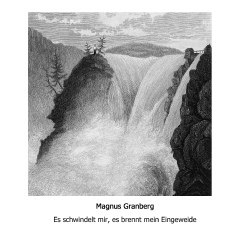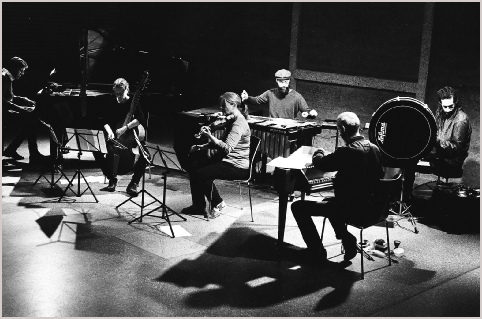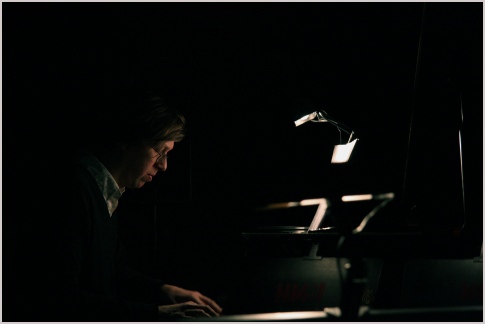Another Timbre TimHarrisonbre

at125 Magnus Granberg - ‘Es schwindelt mir, es brennt mein Eingeweide’ (2017)
Magnus Granberg - prepared piano Anna Lindal - baroque violin
Cyril Bondi - percussion d’incise - vibraphone & electronics
Anna-Kaisa Meklin - viola da gamba Christoph Schiller - spinet
Total time: 62:45
Recorded in Geneva, September 2017
Interview with Magnus Granberg
Could you talk about the background to this piece, and where the unusual title comes from?
In 2015 Christoph Schiller brought together a large ensemble in Basel to perform a work of mine, ‘How Deep is the Ocean, How High is the Sky?’, which was later released on Another Timbre. Several members of that ensemble felt it would be good to do something more. Then last year two of them, d’incise and Cyril Bondi, organised a lovely residency at Fondation l’Abri in Geneva in the last week of August, and they asked me to contribute a new piece that we could work on during the residency. The week ended with a concert presenting all the pieces which had been developed during the residency, and the CD of ‘Es schwindelt mir…’ in fact consists of the recording of the performance at that concert.
Around this time for some reason I had a long period when I’d listen to a particular record by Frank Sinatra, ’No One Cares’, more or less every night after having finished work and put my son to bed. There are many lovely songs on this album, but I became especially attached to the last track on the album, ’None but the Lonely Heart’. This turned out to be an arrangement of a very well-known song by Tchaikovsky, a fact which had somehow had escaped me over the years. And then I realised that Schubert had set the same poem by Goethe, ’Nur wer die Sehnsucht kennt’ from the novel 'Wilhelm Meister’s Apprentice', to music on no less than six occasions, among these the fourth song of the cycle ’Gesänge aus Wilhelm Meister’ which was published in 1826. I guess these are all well-known facts for the erudite, but I confess they were new to me at the time.
Anyhow, once I’d discovered Schubert’s admittedly well-known setting, Sinatra and Tchaikovsky both faded into the background and I became obsessed with Schubert's version, especially the first five or six bars of the introduction. So I took this song and some of its materials as a point of departure for the new piece. But the title itself, ’Es schwindelt mir, es brennt mein Eingeweide', is borrowed from a part of the song from which I actually didn’t take any source materials. So that, roughly, is the background of the piece and how it came about.
Can you translate the title for us, and explain why you were drawn to use it for the piece?
Well, the title always seemed to me a bit difficult to translate into either English or Swedish. A rather literal translation would be something like: ’I’m struck by vertigo, my bowels are burning’, but that doesn’t sound great. I recently found Richard Wigmore’s translation of the Goethe poem for the Hyperion Schubert edition, which is less awkward, but perhaps also a bit trivial compared to the original German: ’I feel giddy, my vitals are aflame’.
The reasons I was drawn to it are also perhaps a bit trivial. I have a habit of taking my titles from text fragments from the songs that I’m using as the source material for the music. This reflects or extends my compositional method, which is to use pre-existing musical fragments as points of departure for the music itself. In this particular case there weren’t too many lines to choose from. One of them is already used for Schubert’s song (’Nur wer die Sehnsucht kennt’), and another (’Allein und abgetrennt von aller Freude’) seems perhaps to be a little too pitiful. The line I chose, ’Es schwindelt mir, es brennt mein Eingeweide’, seems, if still rather romantic, a bit more neutral compared to the other lines. As if it might be not so much a matter of the torments and pains of the narrator’s ego, as a matter of losing one’s foothold, or losing oneself when suddenly confronted with something truly overwhelming. So this interpretation (or justification, perhaps) attracted me, as did the fact that this line is the expressive climax of Schubert’s setting of the poem, an expressiveness that I myself find difficult to relate to. So in the end I didn’t use any of the music from this particular part of the song as source material, but chose to use the line as my title instead. As if the expressiveness of the song has been subdued or silenced and has become something which takes place somewhere beneath the surface of the music.
Tell us more about the nature of the finished work. I know that, although your ensemble pieces always sound fluid and seamless, and aren’t divided into different movements, they nonetheless consist of distinct sections which favour certain phrases or pitches, and so have a particular, if loose, tonal coherence. Can you explain a bit about how ’Es schwindelt mir...’ is organised in this way?
’Es schwindelt mir, es brennt mein Eingeweide’ consists of seven different, comparatively large pools, each containing fragments of written music from which individual players select what to play. The rhythmic materials in the seven pools are all the same, but in performance the rhythmic and temporal totality shifts and changes continuously depending on which materials the players choose to use at any particular moment. So all rhythmic and temporal differentiation occurs spontaneously depending on the nature of the materials themselves as well as the individual and collective choices of the performers. I find that as a performer you quite often use a rather limited selection of the materials available, but each time that pool of material recurs, each musician’s choices will tend to be slightly different, so that the overall sound changes considerably while still retaining a certain coherence.
As regards tonal differentiation, there are seven different modes in the piece, all derived from scales or melodic outlines of the tonality in Schubert’s song. The first and seventh modes were just used once (at the very beginning and at the very end of the piece, respectively), whereas the remaining five modes were used repeatedly in several different sequences of varying lengths which were organised into a larger whole. Within each mode there is a comparatively large selection of melodic fragments, extended melodies, single sounds and chords for the musicians to choose from, so that in performance the formation of chords and melodies continually shifts and changes in a similar way to the rhythmic framework.
In a review of your LP ‘Nattens skogar’ Ben Harper compared your work to Feldman’s late music insofar as “each piece is the same yet each piece is different.” He writes of all your works having “a restrained but taut atmosphere of extreme focus.” How do you respond to that observation, and what do you see as the common features of your compositions across different ensembles, and using sometimes very different source materials?
I think that’s quite an accurate observation: versions of the individual pieces are always very different due to their great degree of variability, but principally still the same since they are all the outcome of the same fundamental conditions. This also applies for the different pieces themselves: they are all very much the outcome of similar premises, of the same DNA. But the outcomes are all slightly different as well, depending on factors such as source materials, interpreters and any whims of the composer himself. So as regards what could be characterised as common features of my music, I would say that some constants would be: variability, co-creation and the use of source materials from pre-existing musics, but also a (developing) set of methods or principles which regulate the transformation of source materials from different times and contexts and turn them into something quite different, while still retaining at least a little something of their original identity.
When you started writing large ensemble pieces you were working exclusively with Skogen, most of whose members are Swedish musicians who you already knew well. Now you have developed pieces with other ensembles - the mainly Swiss-based group on this CD, Skuggorna och Ljuset in Stockholm, and Ensemble Grizzana in the UK – some of whom you didn’t know at all at the start of the process. How has it been working with new musicians, and what would you say are the skills that they need to bring to your pieces to interpret them effectively?
I was very fortunate to have had the possibility of working closely with the members of Skogen when first developing the ideas for my music. It was immensely helpful and a truly formative experience which I couldn’t have done without. But it’s been equally exciting, enriching and rewarding to work with other ensembles, to hear the music take on different forms and qualities when being interpreted by other musicians with their particular, individual experiences, interests, inclinations and ways of approaching music. As regards the skills needed to interpret the music effectively, I guess having experience of playing open scores as well as improvising, and the particular sensibilities involved in these situations, would be beneficial to the music making. This could involve in equal parts a sensibility and flexibility in relation to the musical materials of the piece as well as to the dynamics of playing together, and an ability to engage in the individual and collective processes of choosing, treating and shaping the materials that form the music. It’s also important to have the ability to listen very closely to what everyone is doing while still gently and unrelentingly pursuing one’s own path through the music, so as to enable a counterpoint of processes.




The ensemble at the residency at Fondation l’Abri. Left to right: Magnus Granberg, Anna-Kaisa Meklin, Anna Lindal, d’incise, Christoph Schiller, Cyril Bondi.
Photo: Mehdi Benkler
Photo: Mehdi Benkler
Magnus Granberg
Photo: Mehdi Benkler
Reviews
“In recent years Magnus Granberg has become so prevalent that it is surprising to note his first CD did not come out until 2008, a limited-edition release with the ensemble Skogen. After a stuttering start, recordings came regularly after his first Another Timbre recording, Ist Gefallen in Den Schnee (2012), attracted glowing reviews. Now, Es schwindelt mir, es brennt mein Eingeweide is Granberg's seventh Another Timbre album in as many years. Across the previous six, he has employed ensembles ranging in size from five to twelve members, with various instrumentations. As he did on How Deep is the Ocean, How High is the Sky? (Another Timbre, 2015), for Es schwindelt mir, es brennt mein Eingeweide Granberg chose to employ baroque instruments such as baroque violin, viola de gamba and spinet alongside contemporary ones.
This time around, the music is played by a sextet that is a subset of the nonet on the 2015 disc. Tellingly, the music was recorded at a concert in Geneva in September 2017, after members of the previous nonet said it would be good to work together again, and (sextet members and frequent Granberg collaborators) Cyril Bondi and d’incise organised a week-long workshop for Granberg at Fondation l'Abri in Geneva.
Granberg contributed the new piece "Es schwindelt mir, es brennt mein Eingeweide" to be worked on during the residency. As so often with Granberg compositions, he based the new piece on an existing song. The title translates as "I feel giddy, my vitals are aflame," a quote from a Goethe poem that was set to music by Schubert. Granberg arrived at the Schubert piece via Frank Sinatra's poignant No One Cares album, particularly its track "None but the Lonely Heart" which was based on a Tchaikovsky song using the same Goethe poem.
At over sixty-two minutes long, Granberg's new composition dwarfs any of those source pieces. In typical Granberg fashion, the piece consists of seven sections in different modes, each including various melodic fragments, extended melodies, single sounds and chords that the musicians can choose from. The sections are not separated but lead from one to another seamlessly. The end result of any performance will depend on the many choices made by the individual musicians. The realisation here reveals the piece to be constantly evolving as musicians make individual choices based on hearing the results of others' choices. Despite the ever-changing nature of the music, the ensemble sounds coherent throughout, without any clunky non-sequiturs or jump cuts; that week-long workshop had obviously done a good job in preparing the players for the closing performance. As before, the combination of baroque instruments with electronics, percussion and Granberg's prepared piano works far better in reality than it might sound in theory.
Altogether, this album is unmistakably Granberg, displaying all of the individual touches that make his music distinctive and successful. It fits into neatly into his already impressive discography. And there can be no higher praise than that.”
John Eyles, All About Jazz
“The title of this album comes of the Goethe poem originally set to music by Franz Schubert. In a poem about solitude and loneliness, the phrase means something like, “It unnerves me, it burns my viscera.” Interestingly, Granberg interprets the phrase more colloquially as “I feel giddy, my vitals are inflamed.”
This performance of Es schwindelt mir embodies the gravity of the first translation. Using Schubert’s original as a deconstructed scalar and melodic basis for the piece, Granberg has created something utterly engrossing. The six-person group includes Bondi (percussion), Schiller (spinet), d’incise (electronics and vibraphone), and Granberg himself (piano), as well as veterans of previous Granberg releases Anna-Kaisa Meklin (viola da gamba) and Anna Lindal (baroque violin).
The instrumentation reflects that of “Tse,” but to very different effect. There is more space in this composition, as the instrumentalists oscillate around a baseline unnerving quiet with more individual expressiveness than the meditative droning and muted orchestration of the releases reviewed above.”
Nick Ostrum, Free Jazz Blog